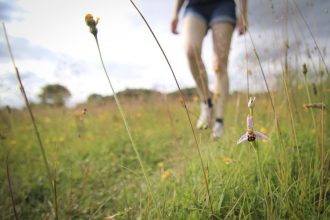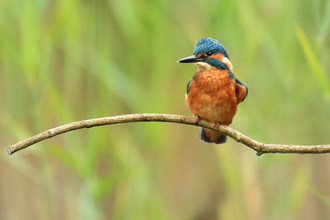It’s a really great time of year to get outside for a wild adventure and explore some of our sites. Here are some of the things you could look forward to seeing.
Latest wildlife sightings – March 2019
Little Woolden Moss
One of our Carbon Landscape trainees, Andrew Hankinson, had a very brief encounter with a weasel on Little Woolden Moss just last week! He has also spotted hares, curlews and lapwings on the reserve over the last few weeks, which shows that all of our hard conservation work on the Moss is paying off.
Lunt Meadows
The Lunt Meadows team hasn’t stopped! The new hide is very nearly finished and we’ve been hard at work finishing preparations for the breeding season.
Bird-wise, spring migrants are coming in thick and fast with sand martins, swallows and chiffchaffs arriving at the reserve. A little ringed plover was eyeing up the new islands so we have our fingers crossed for breeding, and very excitingly, an osprey was spotted flying overhead on 29 March!
Out on the pools, great crested grebes are displaying and black-tailed godwits are coming into their stunning summer plumage. It’s worth a visit to Lunt Meadows just to see the godwits with their rust-coloured chests and bellies.
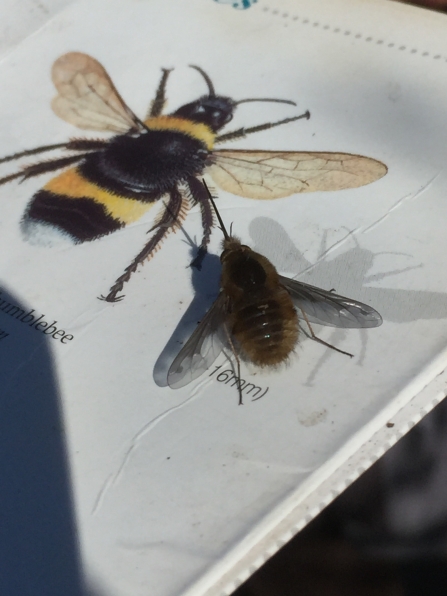
A bee-fly checking out the furry competition. Photo by Adam Berry
Seven Acres
Have you ever seen a bee-fly before? Our Nature Reserve Engagement Officer, Adam Berry, spotted one at Seven Acres with the Seven Acres Squad volunteers. It is a dark-edged bee-fly (also known as the large bee-fly), and despite looking like a small bumblebee, it is indeed a fly. It is what’s known as a ‘bee mimc’ – this allows it to fly up close to bee burrows and flick its eggs inside, where the larvae parasitise the bees.
Dark-edged bee-flies feed on flowers like primroses and celandines on sunny days, so keep your eyes peeled!
Mere Sands Wood
24 sand martins were seen over the Mere Sands Wood visitor centre just last week. And if that wasn’t an exciting enough sign of spring, great crested grebes have been displaying and nest-building on Mere End Lake. Settle down in the Cyril Gibbons hide early in the morning to try and spot their elegant courtship display.
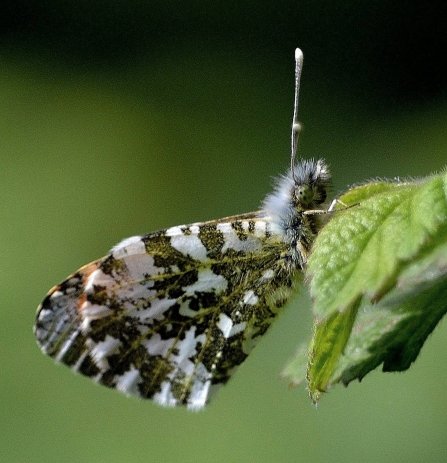
Orange tip butterfly by Ken Hayes
Brockholes Nature Reserve
Walks around Brockholes have been accompanied by the spring soundtrack of chiffchaffs this month. There is no mistaking their call: ‘chiff-chaff-chiff-chaff’.
Life has been busy on the reserve, with orange tip butterflies feeding on wildflowers and a blackcap spotted near Nook Pool, where toads have been busy mating and spawning. Sand martins are returning, ready to breed, and a grey wagtail was spotted flitting about on the Weir.
But March hasn’t just been about birds and bugs – wildflowers are painting Brockholes with beautiful splashes of colour. Bluebells, wood anemones and lesser celandines are out in Boilton Wood, while the strange pink spikes of butterbur have appeared in wetter areas. Its flowers might look small and a little scraggly, but many bees use them as a source of early nectar.
Middleton Nature Reserve
Middleton has become a real haven for Cetti’s warblers. We had four singing on the reserve in March, a number that would have been headline news a few years ago but now you can hear them on every visit, all year round.
Other notable sightings have included water rails, lesser redpolls, little grebes, a sparrowhawk, house martins and a green woodpecker.
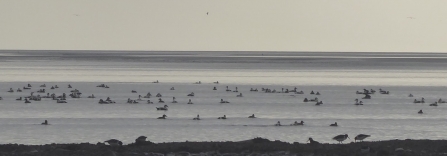
A flock of around 400 eiders at Heysham. Photo by Pete Marsh
Heysham
There is always so much to see in the Heysham area, and last month was no exception.
A barn owl, roe deer and jays were welcome sights to visitors to Heysham Moss, while at Heysham Nature Reserve, spring has well and truly been in the air. Chiffchaffs have been calling, speckled wood butterflies have been flitting and a male Cetti’s warbler was heard singing on the north side of the reserve. There was also a lot of excitement during a bird ringing session when we recaught an elderly chaffinch. The ring on its leg told us that it was six years old! According to the British Trust for Ornitholigy (BTO), most chaffinches only live for three years, while the longest lived was recorded elsewhere in the country in 2011. This truly ancient bird was 13 years and 11 months old!
Pale-bellied Brent geese are still feeding at Red Nab, off Heysham Harbour, in double figures, while a raven and wheatear have also been seen in this area. A stonechat stopped off briefly at Ocean Edge foreshore, and an osprey was recorded flying over Half Moon Bay. Our ‘seawatch’ sessions at Heysham Head have proved fruitful: a velvet scoter was spotted, and around 400 eider ducks have been bobbing around at low tide.
Moth-wise, trapping sessions are getting more and more exciting with many spring species now appearing. We’ve had common plume, Hebrew character, common quaker, clouded drab, early grey and shoulder stripe moths inside.
What have you spotted on our nature reserves? With spring in full swing we’re expecting lots more insects, birds and wildflowers in the coming weeks. Tell us all about your sightings on Facebook, Twitter or Instagram!
And in the meantime, why not plan your next adventure out to see some of this wonderful spring wildlife?


